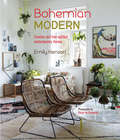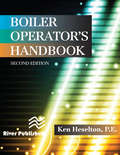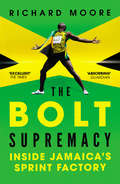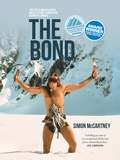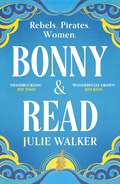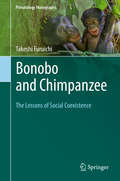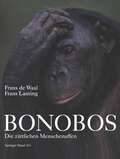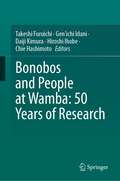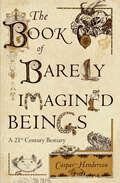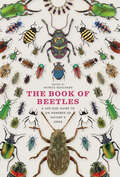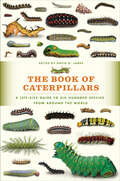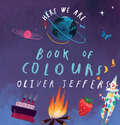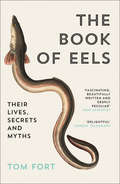- Table View
- List View
Bohemian Modern: Imaginative And Affordable Ideas For A Creative And Beautiful Home
by Emily HensonEmily Henson explores the elements that come together to create this eclectic, colourful and contemporary look and draws inspiration from an array of real-life Bohemian Modern homes.
Boiler Operator's Handbook, Second Edition
by P. E. HeseltonThis book was written specifically for boiler plan operators and supervisors who want to learn how to lower plant operating costs, as well as how to operate plants of all types and sizes more wisely. It is newly revised with guidelines for HRSGs, combined cycle systems, and environmental effects of boiler operation. Also included is a new chapter on refrigeration systems that addresses the environmental effects of inadvertent and intentional discharges of refrigerants. Going beyond the basics of "keeping the pressure up," the author explains in clear terms how to set effective priorities to ensure optimal plant operation, including ensuring safety and continuity of operations, preventing damage, managing environmental impact, training replacement plant operators, logging and preserving historical data, and operating the plant economically.
The Bolt Supremacy: Inside Jamaica’s Sprint Factory
by Richard MooreBeijing 2008, the 100 metres final: Usain Bolt slows down, beats his chest, metres clear of his nearest rival, his face filled with the euphoria of a young man utterly in thrall to his extraordinary physical talent. It is one of the greatest sporting moments. It is just the beginning.Of the ten fastest 100-metres times in history, eight belong to Jamaicans. How is it that a small Caribbean island has come to almost totally dominate the men’s and women’s sprint events?The Bolt Supremacy opens the doors to a community where sprinting permeates conversations and interactions; where the high school championships are watched by 35,000 screaming fans; where identity, success and status are forged on the track, and where making it is a pass to a world of adoration and lucrative contracts. In such a society there can be the incentive for some to cheat. There are those who attribute Jamaican success to something beyond talent and hard work. Award-winning writer Richard Moore doesn’t shy away from difficult questions as he travels the length of this beguiling country speaking to anti-doping agencies, scientists and sceptics as well as to coaches, gurus, superstar athletes and the young guns desperate to become the next big thing. Peeling back the layers, Moore finally reveals the secrets of Usain Bolt and the Jamaican sprint factory.
The Bond: Two epic climbs in Alaska and a lifetime's connection between climbers
by Simon McCartneyShortlisted: 2016 Boardman Tasker Prize for Mountain LiteratureShortlisted: 2016 Banff Mountain Book Competition‘It's the classic of post-war mountain writing.’ – Jim Perrin‘Rarely do I encounter a cannot-put-down book, but Simon McCartney’s aptly titled The Bond is exceptional in many ways.’ – Tom HornbeinSimon McCartney was a cocky young British alpinist climbing many of the hardest routes in the Alps during the late seventies, but it was a chance meeting in Chamonix in 1977 with Californian ‘Stonemaster’ Jack Roberts that would dramatically change both their lives – and almost end Simon’s.Inspired by a Bradford Washburn photograph published in Mountain magazine, their first objective was the 5,500-foot north face of Mount Huntington, one of the most dangerous walls in the Alaska Range. The result was a route so hard and serious that for decades nobody believed they had climbed it – it is still unrepeated to this day. Then, raising the bar even higher, they made the first ascent of the south-west face of Denali, a climb that would prove almost fatal for Simon, and one which would break the bond between him and climbing, separating the two young climbers. But the bond between Simon and Jack couldn’t remain dormant forever. A lifetime later, a chance reconnection with Jack gave Simon the chance to bury the ghosts of what happened high on Denali, when he had faced almost certain death.The Bond is Simon McCartney’s story of these legendary climbs.
Bonny & Read
by Julie Walker'A cracking read. . . Fascinating, complex characters and a real page-turner!'LIZ HYDER, author of THE GIFTS 'Bonny and Read has it all. Adventure, atmosphere, sizzling suspense and unforgettable characters. Such a brilliant debut!'SD SYKES, author of THE GOOD DEATH'A deftly told tale of the complexities of friendship, female identity & freedom, featuring two remarkable women determined to define their own destinies . . . the pages turn themselves'ANITA FRANK, author of THE LOST ONES'What a debut! A fabulous, dangerous sea-shanty of a story' KATIE MUNNIK, author of THE AERIALISTSRebels. Pirates. Women. Caribbean, 1720. Two extraordinary women are on the run - from their pasts, from the British Navy and the threat of execution, and from the destiny that fate has written for them.Plantation owner's daughter, runaway wife, pirate - Anne Bonny has forged her own story in a man's world. But when she is involved in the capture of a British merchant ship, she is amazed to find another woman amongst the crew, with a history as unconventional as her own. Dressed as a boy from childhood, Mary Read has been a soldier, a sailor, a widow - but never a woman in charge of her own destiny.As their exhilarating, tumultuous exploits find fame, the ballad of Bonny and Read is sung from shore to shore - but when you swim against the tide of history, freedom is a dangerous thing...An exuberant reimagining of the extraordinary story of Bonny & Read - trailblazing, boundary-defying, swashbuckling heroines whose story deserves to be known. Perfect for fans of Ariadne, The Mercies and The Familiars.
Bonobo and Chimpanzee: The Lessons of Social Coexistence (Primatology Monographs)
by Takeshi FuruichiThis book describes the similarities and differences between two species, bonobos and chimpanzees, based on the three decades the author has spent studying them in the wild, and shows how the contrasting nature of these two species is also reflected in human nature. The most important differences between bonobos and chimpanzees, our closest relatives, are the social mechanisms of coexistence in group life. Chimpanzees are known as a fairly despotic species in which the males exclusively dominate over the females, and maintain a rigid hierarchy. Chimpanzees have developed social intelligence to survive severe competition among males: by upholding the hierarchy of dominance, they can usually preserve peaceful relations among group members. In contrast, female bonobos have the same or even a higher social status than males. By evolving pseudo-estrus during their non-reproductive period, females have succeeded in moderating inter-male sexual competition, and in initiating mate selection. Although they are non-related in male-philopatric society, they usually aggregate in a group, enjoy priority access to food, determine which male is the alpha male, and generally maintain much more peaceful social relations compared to chimpanzees. Lastly, by identifying key mechanisms of social coexistence in these two species, the author also seeks to find solutions or “hope” for the peaceful coexistence of human beings."Takeshi Furuichi is one of very few scientists in the world familiar with both chimpanzees and bonobos. In lively prose, reflecting personal experience with apes in the rain forest, he compares our two closest relatives and explains the striking differences between the male- dominated and territorial chimpanzees and the female-centered gentle bonobos."Frans de Waal, author of Mama’s Last Hug - Animal Emotions and What They Tell Us about Ourselves (Norton, 2019)
Bonobos and People at Wamba: 50 Years of Research
by Takeshi Furuichi Gen'Ichi Idani Daiji Kimura Hiroshi Ihobe Chie HashimotoThis book reviews all the findings about bonobos and the local people of Wamba village in the Luo Scientific Reserve in the Democratic Republic of the Congo over the last 50 years. In 1973, Takayoshi Kano, a Japanese primatologist, traveled across a vast area of the Congo Basin with a bicycle and found Wamba village to be a promising site to start his first studies on wild bonobos. Since then, many researchers from Japan and all over the world have been working at Wamba, now the longest standing study site, to uncover various aspects of the ecology and behavior of this most recently identified great ape species. The researchers study bonobo behaviors and carry out various activities for the conservation of bonobos. They also conduct anthropological studies of local people who live with bonobos and believe them to be distant relatives from the same family, living in the forest. This book is published in commemoration of 2023 marking the 50th year of study. The main chapters are contributed by active researchers studying bonobos and the local people at Wamba. The book also includes contributions from various eminent researchers who have carried out short-term research or have supported research at Wamba, which helps place these studies of bonobos in a broader primatological or anthropological perspective. This book will be a useful resource for professional researchers in primatology and anthropology, as well as graduate or undergraduate students interested in these research fields.
The Book of Barely Imagined Beings: A 21st Century Bestiary
by Caspar HendersonFrom medieval bestiaries to Borges’s Book of Imaginary Beings, we’ve long been enchanted by extraordinary animals, be they terrifying three-headed dogs or asps impervious to a snake charmer’s song. But bestiaries are more than just zany zoology—they are artful attempts to convey broader beliefs about human beings and the natural order. Today, we no longer fear sea monsters or banshees. But from the infamous honey badger to the giant squid, animals continue to captivate us with the things they can do and the things they cannot, what we know about them and what we don’t. With The Book of Barely Imagined Beings, Caspar Henderson offers readers a fascinating, beautifully produced modern-day menagerie. But whereas medieval bestiaries were often based on folklore and myth, the creatures that abound in Henderson’s book—from the axolotl to the zebrafish—are, with one exception, very much with us, albeit sometimes in depleted numbers. The Book of Barely Imagined Beings transports readers to a world of real creatures that seem as if they should be made up—that are somehow more astonishing than anything we might have imagined. The yeti crab, for example, uses its furry claws to farm the bacteria on which it feeds. The waterbear, meanwhile, is among nature’s “extreme survivors,” able to withstand a week unprotected in outer space. These and other strange and surprising species invite readers to reflect on what we value—or fail to value—and what we might change. A powerful combination of wit, cutting-edge natural history, and philosophical meditation, The Book of Barely Imagined Beings is an infectious and inspiring celebration of the sheer ingenuity and variety of life in a time of crisis and change.
The Book of Barely Imagined Beings: A 21st Century Bestiary
by Caspar HendersonFrom medieval bestiaries to Borges’s Book of Imaginary Beings, we’ve long been enchanted by extraordinary animals, be they terrifying three-headed dogs or asps impervious to a snake charmer’s song. But bestiaries are more than just zany zoology—they are artful attempts to convey broader beliefs about human beings and the natural order. Today, we no longer fear sea monsters or banshees. But from the infamous honey badger to the giant squid, animals continue to captivate us with the things they can do and the things they cannot, what we know about them and what we don’t. With The Book of Barely Imagined Beings, Caspar Henderson offers readers a fascinating, beautifully produced modern-day menagerie. But whereas medieval bestiaries were often based on folklore and myth, the creatures that abound in Henderson’s book—from the axolotl to the zebrafish—are, with one exception, very much with us, albeit sometimes in depleted numbers. The Book of Barely Imagined Beings transports readers to a world of real creatures that seem as if they should be made up—that are somehow more astonishing than anything we might have imagined. The yeti crab, for example, uses its furry claws to farm the bacteria on which it feeds. The waterbear, meanwhile, is among nature’s “extreme survivors,” able to withstand a week unprotected in outer space. These and other strange and surprising species invite readers to reflect on what we value—or fail to value—and what we might change. A powerful combination of wit, cutting-edge natural history, and philosophical meditation, The Book of Barely Imagined Beings is an infectious and inspiring celebration of the sheer ingenuity and variety of life in a time of crisis and change.
The Book of Barely Imagined Beings: A 21st Century Bestiary
by Caspar HendersonFrom medieval bestiaries to Borges’s Book of Imaginary Beings, we’ve long been enchanted by extraordinary animals, be they terrifying three-headed dogs or asps impervious to a snake charmer’s song. But bestiaries are more than just zany zoology—they are artful attempts to convey broader beliefs about human beings and the natural order. Today, we no longer fear sea monsters or banshees. But from the infamous honey badger to the giant squid, animals continue to captivate us with the things they can do and the things they cannot, what we know about them and what we don’t. With The Book of Barely Imagined Beings, Caspar Henderson offers readers a fascinating, beautifully produced modern-day menagerie. But whereas medieval bestiaries were often based on folklore and myth, the creatures that abound in Henderson’s book—from the axolotl to the zebrafish—are, with one exception, very much with us, albeit sometimes in depleted numbers. The Book of Barely Imagined Beings transports readers to a world of real creatures that seem as if they should be made up—that are somehow more astonishing than anything we might have imagined. The yeti crab, for example, uses its furry claws to farm the bacteria on which it feeds. The waterbear, meanwhile, is among nature’s “extreme survivors,” able to withstand a week unprotected in outer space. These and other strange and surprising species invite readers to reflect on what we value—or fail to value—and what we might change. A powerful combination of wit, cutting-edge natural history, and philosophical meditation, The Book of Barely Imagined Beings is an infectious and inspiring celebration of the sheer ingenuity and variety of life in a time of crisis and change.
The Book of Barely Imagined Beings: A 21st Century Bestiary
by Caspar HendersonFrom medieval bestiaries to Borges’s Book of Imaginary Beings, we’ve long been enchanted by extraordinary animals, be they terrifying three-headed dogs or asps impervious to a snake charmer’s song. But bestiaries are more than just zany zoology—they are artful attempts to convey broader beliefs about human beings and the natural order. Today, we no longer fear sea monsters or banshees. But from the infamous honey badger to the giant squid, animals continue to captivate us with the things they can do and the things they cannot, what we know about them and what we don’t. With The Book of Barely Imagined Beings, Caspar Henderson offers readers a fascinating, beautifully produced modern-day menagerie. But whereas medieval bestiaries were often based on folklore and myth, the creatures that abound in Henderson’s book—from the axolotl to the zebrafish—are, with one exception, very much with us, albeit sometimes in depleted numbers. The Book of Barely Imagined Beings transports readers to a world of real creatures that seem as if they should be made up—that are somehow more astonishing than anything we might have imagined. The yeti crab, for example, uses its furry claws to farm the bacteria on which it feeds. The waterbear, meanwhile, is among nature’s “extreme survivors,” able to withstand a week unprotected in outer space. These and other strange and surprising species invite readers to reflect on what we value—or fail to value—and what we might change. A powerful combination of wit, cutting-edge natural history, and philosophical meditation, The Book of Barely Imagined Beings is an infectious and inspiring celebration of the sheer ingenuity and variety of life in a time of crisis and change.
The Book of Barely Imagined Beings: A 21st Century Bestiary
by Caspar HendersonFrom medieval bestiaries to Borges’s Book of Imaginary Beings, we’ve long been enchanted by extraordinary animals, be they terrifying three-headed dogs or asps impervious to a snake charmer’s song. But bestiaries are more than just zany zoology—they are artful attempts to convey broader beliefs about human beings and the natural order. Today, we no longer fear sea monsters or banshees. But from the infamous honey badger to the giant squid, animals continue to captivate us with the things they can do and the things they cannot, what we know about them and what we don’t. With The Book of Barely Imagined Beings, Caspar Henderson offers readers a fascinating, beautifully produced modern-day menagerie. But whereas medieval bestiaries were often based on folklore and myth, the creatures that abound in Henderson’s book—from the axolotl to the zebrafish—are, with one exception, very much with us, albeit sometimes in depleted numbers. The Book of Barely Imagined Beings transports readers to a world of real creatures that seem as if they should be made up—that are somehow more astonishing than anything we might have imagined. The yeti crab, for example, uses its furry claws to farm the bacteria on which it feeds. The waterbear, meanwhile, is among nature’s “extreme survivors,” able to withstand a week unprotected in outer space. These and other strange and surprising species invite readers to reflect on what we value—or fail to value—and what we might change. A powerful combination of wit, cutting-edge natural history, and philosophical meditation, The Book of Barely Imagined Beings is an infectious and inspiring celebration of the sheer ingenuity and variety of life in a time of crisis and change.
The Book of Barely Imagined Beings: A 21st Century Bestiary
by Caspar HendersonFrom medieval bestiaries to Borges’s Book of Imaginary Beings, we’ve long been enchanted by extraordinary animals, be they terrifying three-headed dogs or asps impervious to a snake charmer’s song. But bestiaries are more than just zany zoology—they are artful attempts to convey broader beliefs about human beings and the natural order. Today, we no longer fear sea monsters or banshees. But from the infamous honey badger to the giant squid, animals continue to captivate us with the things they can do and the things they cannot, what we know about them and what we don’t. With The Book of Barely Imagined Beings, Caspar Henderson offers readers a fascinating, beautifully produced modern-day menagerie. But whereas medieval bestiaries were often based on folklore and myth, the creatures that abound in Henderson’s book—from the axolotl to the zebrafish—are, with one exception, very much with us, albeit sometimes in depleted numbers. The Book of Barely Imagined Beings transports readers to a world of real creatures that seem as if they should be made up—that are somehow more astonishing than anything we might have imagined. The yeti crab, for example, uses its furry claws to farm the bacteria on which it feeds. The waterbear, meanwhile, is among nature’s “extreme survivors,” able to withstand a week unprotected in outer space. These and other strange and surprising species invite readers to reflect on what we value—or fail to value—and what we might change. A powerful combination of wit, cutting-edge natural history, and philosophical meditation, The Book of Barely Imagined Beings is an infectious and inspiring celebration of the sheer ingenuity and variety of life in a time of crisis and change.
The Book of Beetles: A Life-Size Guide to Six Hundred of Nature's Gems
by Patrice BouchardWhen renowned British geneticist J. B. S. Haldane was asked what could be inferred about God from a study of his works, Haldane replied, “An inordinate fondness for beetles.” With 350,000 known species, and scientific estimates that millions more have yet to be identified, their abundance is indisputable as is their variety. They range from the delightful summer firefly to the one-hundred-gram Goliath beetle. Beetles offer a dazzling array of shapes, sizes, and colors that entice scientists and collectors across the globe. The Book of Beetles celebrates the beauty and diversity of this marvelous insect. Six hundred significant beetle species are covered, with each entry featuring a distribution map, basic biology, conservation status, and information on cultural and economic significance. Full-color photos show the beetles both at their actual size and enlarged to show details, such as the sextet of spots that distinguish the six-spotted tiger beetle or the jagged ridges of the giant-jawed sawyer beetle. Based in the most up-to-date science and accessibly written, the descriptive text will appeal to researchers and armchair coleopterists alike. The humble beetle continues to grow in popularity, taking center stage in biodiversity studies, sustainable agriculture programs, and even the dining rooms of adventurous and eco-conscious chefs. The Book of Beetles is certain to become the authoritative reference on these remarkably adaptable and beautiful creatures.
The Book of Beetles: A Life-Size Guide to Six Hundred of Nature's Gems
by Patrice BouchardWhen renowned British geneticist J. B. S. Haldane was asked what could be inferred about God from a study of his works, Haldane replied, “An inordinate fondness for beetles.” With 350,000 known species, and scientific estimates that millions more have yet to be identified, their abundance is indisputable as is their variety. They range from the delightful summer firefly to the one-hundred-gram Goliath beetle. Beetles offer a dazzling array of shapes, sizes, and colors that entice scientists and collectors across the globe. The Book of Beetles celebrates the beauty and diversity of this marvelous insect. Six hundred significant beetle species are covered, with each entry featuring a distribution map, basic biology, conservation status, and information on cultural and economic significance. Full-color photos show the beetles both at their actual size and enlarged to show details, such as the sextet of spots that distinguish the six-spotted tiger beetle or the jagged ridges of the giant-jawed sawyer beetle. Based in the most up-to-date science and accessibly written, the descriptive text will appeal to researchers and armchair coleopterists alike. The humble beetle continues to grow in popularity, taking center stage in biodiversity studies, sustainable agriculture programs, and even the dining rooms of adventurous and eco-conscious chefs. The Book of Beetles is certain to become the authoritative reference on these remarkably adaptable and beautiful creatures.
The Book of Beetles: A Life-Size Guide to Six Hundred of Nature's Gems
by Patrice BouchardWhen renowned British geneticist J. B. S. Haldane was asked what could be inferred about God from a study of his works, Haldane replied, “An inordinate fondness for beetles.” With 350,000 known species, and scientific estimates that millions more have yet to be identified, their abundance is indisputable as is their variety. They range from the delightful summer firefly to the one-hundred-gram Goliath beetle. Beetles offer a dazzling array of shapes, sizes, and colors that entice scientists and collectors across the globe. The Book of Beetles celebrates the beauty and diversity of this marvelous insect. Six hundred significant beetle species are covered, with each entry featuring a distribution map, basic biology, conservation status, and information on cultural and economic significance. Full-color photos show the beetles both at their actual size and enlarged to show details, such as the sextet of spots that distinguish the six-spotted tiger beetle or the jagged ridges of the giant-jawed sawyer beetle. Based in the most up-to-date science and accessibly written, the descriptive text will appeal to researchers and armchair coleopterists alike. The humble beetle continues to grow in popularity, taking center stage in biodiversity studies, sustainable agriculture programs, and even the dining rooms of adventurous and eco-conscious chefs. The Book of Beetles is certain to become the authoritative reference on these remarkably adaptable and beautiful creatures.
The Book of Beetles: A Life-Size Guide to Six Hundred of Nature's Gems
by Patrice BouchardWhen renowned British geneticist J. B. S. Haldane was asked what could be inferred about God from a study of his works, Haldane replied, “An inordinate fondness for beetles.” With 350,000 known species, and scientific estimates that millions more have yet to be identified, their abundance is indisputable as is their variety. They range from the delightful summer firefly to the one-hundred-gram Goliath beetle. Beetles offer a dazzling array of shapes, sizes, and colors that entice scientists and collectors across the globe. The Book of Beetles celebrates the beauty and diversity of this marvelous insect. Six hundred significant beetle species are covered, with each entry featuring a distribution map, basic biology, conservation status, and information on cultural and economic significance. Full-color photos show the beetles both at their actual size and enlarged to show details, such as the sextet of spots that distinguish the six-spotted tiger beetle or the jagged ridges of the giant-jawed sawyer beetle. Based in the most up-to-date science and accessibly written, the descriptive text will appeal to researchers and armchair coleopterists alike. The humble beetle continues to grow in popularity, taking center stage in biodiversity studies, sustainable agriculture programs, and even the dining rooms of adventurous and eco-conscious chefs. The Book of Beetles is certain to become the authoritative reference on these remarkably adaptable and beautiful creatures.
The Book of Beijing: A City in short fiction (Reading the City)
by Qiu Huadong Ning Ken Xu Kun Fu Xiuying Gu Shi Yu Wenling Shi Yifeng Xu Zechen Wen Zhen Han SongTwo former college friends run into each other on the morning train and find themselves reflecting on the very different paths their lives have taken... A counterfeiter, forever living outside the law, starts to envy a friend who’s managed to get out of the game and establish a normal life... A security officer in a futuristic version of Beijing West Railway Station chases down a passenger who the screens say is ‘intentionally lost’... Beijing may be known to us, in the West, as the political powerhouse of the most populous country in the world, but to the characters in these stories it is a protean city, forever changing, evasive and difficult to read... It turns close friends into strangers, up-ends carefully thought-out life choices, and leaves next-door neighbours completely unaware of each other’s true identity. The stories collected in this anthology show people in all contexts – from wannabe protestors to future users of facial expression reading tech – desperate to stake their name on the city, as well as surprised by it at every turn. Featuring translations by Eric Abrahamsen, Paul Harris, Jack Hargreaves, Hongyu Jasmine Zhu, Christopher MacDonald, Carson Ramsdell, Florence Taylor, Alison Sharpless, Katherine Tse, and Helen Wang.
The Book of Caterpillars: A Life-Size Guide to Six Hundred Species from around the World
by David G. JamesThe weird and wonderful world of insects boasts some of the strangest creatures found in nature, and caterpillars are perhaps the most bizarre of all. While most of us picture caterpillars as cute fuzzballs munching on leaves, there is much more to them than we imagine. A caterpillar’s survival hinges on finding enough food and defending itself from the array of natural enemies lined up to pounce and consume. And the astounding adaptations and strategies they have developed to maximize their chances of becoming a butterfly or moth are only just beginning to be understood, from the Spicebush Swallowtail caterpillar that resembles a small snake to the Eastern Carpenter Bee Hawkmoth caterpillar that attempts to dissuade potential predators by looking like a diseased leaf. The Book of Caterpillars unveils the mysteries of six hundred species from around the world, introducing readers to the complexity and beauty of these underappreciated insects. With the advent of high-quality digital macrophotography, the world of caterpillars is finally opening up. The book presents a wealth of stunning imagery that showcases the astonishing diversity of caterpillar design, structure, coloration, and patterning. Each entry also features a two-tone engraving of the adult specimen, emphasizing the wing patterns and shades, as well as a population distribution map and table of essential information that includes their habitat, typical host plants, and conservation status. Throughout the book are fascinating facts that will enthrall expert entomologists and curious collectors alike. A visually rich and scientifically accurate guide to six hundred of the world’s most peculiar caterpillars, this volume presents readers with a rare, detailed look at these intriguing forms of insect life.
The Book of Caterpillars: A Life-Size Guide to Six Hundred Species from around the World
by David G. JamesThe weird and wonderful world of insects boasts some of the strangest creatures found in nature, and caterpillars are perhaps the most bizarre of all. While most of us picture caterpillars as cute fuzzballs munching on leaves, there is much more to them than we imagine. A caterpillar’s survival hinges on finding enough food and defending itself from the array of natural enemies lined up to pounce and consume. And the astounding adaptations and strategies they have developed to maximize their chances of becoming a butterfly or moth are only just beginning to be understood, from the Spicebush Swallowtail caterpillar that resembles a small snake to the Eastern Carpenter Bee Hawkmoth caterpillar that attempts to dissuade potential predators by looking like a diseased leaf. The Book of Caterpillars unveils the mysteries of six hundred species from around the world, introducing readers to the complexity and beauty of these underappreciated insects. With the advent of high-quality digital macrophotography, the world of caterpillars is finally opening up. The book presents a wealth of stunning imagery that showcases the astonishing diversity of caterpillar design, structure, coloration, and patterning. Each entry also features a two-tone engraving of the adult specimen, emphasizing the wing patterns and shades, as well as a population distribution map and table of essential information that includes their habitat, typical host plants, and conservation status. Throughout the book are fascinating facts that will enthrall expert entomologists and curious collectors alike. A visually rich and scientifically accurate guide to six hundred of the world’s most peculiar caterpillars, this volume presents readers with a rare, detailed look at these intriguing forms of insect life.
The Book of Caterpillars: A Life-Size Guide to Six Hundred Species from around the World
by David G. James Sally Morgan Andrei SourakovThe weird and wonderful world of insects boasts some of the strangest creatures found in nature, and caterpillars are perhaps the most bizarre of all. While most of us picture caterpillars as cute fuzzballs munching on leaves, there is much more to them than we imagine. A caterpillar’s survival hinges on finding enough food and defending itself from the array of natural enemies lined up to pounce and consume. And the astounding adaptations and strategies they have developed to maximize their chances of becoming a butterfly or moth are only just beginning to be understood, from the Spicebush Swallowtail caterpillar that resembles a small snake to the Eastern Carpenter Bee Hawkmoth caterpillar that attempts to dissuade potential predators by looking like a diseased leaf. The Book of Caterpillars unveils the mysteries of six hundred species from around the world, introducing readers to the complexity and beauty of these underappreciated insects. With the advent of high-quality digital macrophotography, the world of caterpillars is finally opening up. The book presents a wealth of stunning imagery that showcases the astonishing diversity of caterpillar design, structure, coloration, and patterning. Each entry also features a two-tone engraving of the adult specimen, emphasizing the wing patterns and shades, as well as a population distribution map and table of essential information that includes their habitat, typical host plants, and conservation status. Throughout the book are fascinating facts that will enthrall expert entomologists and curious collectors alike. A visually rich and scientifically accurate guide to six hundred of the world’s most peculiar caterpillars, this volume presents readers with a rare, detailed look at these intriguing forms of insect life.
The Book of Caterpillars: A Life-Size Guide to Six Hundred Species from around the World
The weird and wonderful world of insects boasts some of the strangest creatures found in nature, and caterpillars are perhaps the most bizarre of all. While most of us picture caterpillars as cute fuzzballs munching on leaves, there is much more to them than we imagine. A caterpillar’s survival hinges on finding enough food and defending itself from the array of natural enemies lined up to pounce and consume. And the astounding adaptations and strategies they have developed to maximize their chances of becoming a butterfly or moth are only just beginning to be understood, from the Spicebush Swallowtail caterpillar that resembles a small snake to the Eastern Carpenter Bee Hawkmoth caterpillar that attempts to dissuade potential predators by looking like a diseased leaf. The Book of Caterpillars unveils the mysteries of six hundred species from around the world, introducing readers to the complexity and beauty of these underappreciated insects. With the advent of high-quality digital macrophotography, the world of caterpillars is finally opening up. The book presents a wealth of stunning imagery that showcases the astonishing diversity of caterpillar design, structure, coloration, and patterning. Each entry also features a two-tone engraving of the adult specimen, emphasizing the wing patterns and shades, as well as a population distribution map and table of essential information that includes their habitat, typical host plants, and conservation status. Throughout the book are fascinating facts that will enthrall expert entomologists and curious collectors alike. A visually rich and scientifically accurate guide to six hundred of the world’s most peculiar caterpillars, this volume presents readers with a rare, detailed look at these intriguing forms of insect life.
Book of Colours (Here We Are)
by Oliver JeffersA spectacular concept book from world-renowned artist Oliver Jeffers, based on his million-copy selling, global phenomenon Here We Are!
The Book of Eels
by Tom FortWhat has been the dish of kings, the subject of myths and the traveller of epic and mysterious journeys? The eel.
